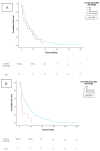Post-Operative Urinary Tract Infections After Radical Cystectomy: Incidence, Pathogens, and Risk Factors
- PMID: 39597940
- PMCID: PMC11594803
- DOI: 10.3390/jcm13226796
Post-Operative Urinary Tract Infections After Radical Cystectomy: Incidence, Pathogens, and Risk Factors
Abstract
Background: The incidence of urinary tract infections (UTIs) after radical cystectomy (RC) with urinary diversion (UD), the typical pathogens, and associated patient risk factors have not been well documented. In this study, we examined the incidence of post-op UTIs after RC to identify associated risk factors. Methods: Single-center, retrospective case series of 386 patients with bladder cancer who underwent RC with UD between 2012 and 2024. The primary objective was UTI incidence, defined by the frequency of patients with urine culture with >105 colony-forming units per high-powered field, spanning from post-op day 0 (POD0) to 90 days after discharge. Isolated pathogens were reported. Risk factors for UTIs were assessed. Results: The average age was 69 years old at surgery, and patients were predominantly male (80%). The cumulative incidence of post-op UTIs was 14%, among which 12 patients had more than one UTI. The UTI incidence was 2%, 8%, and 7% during the immediate post-op period, within 30 days, and within 31-90 days, respectively. Isolated pathogens included Escherichia coli (26%), Enterococcus faecalis (24%), Klebsiella pneumoniae (21%), and Pseudomonas species (21%). In the immediate post-op period, female sex was the only significant risk factor. At 31 to 90 days, cutaneous ureterostomy UD was the predominant risk factor for UTIs. For ileal conduit patients, those with a Wallace ureteral anastomosis were associated with UTI 31-90 days from discharge for RC. Conclusions: Our retrospective data suggests the incidence of UTIs and their causative pathogens after RC differ based on post-operative time points and vary according to different patient risk factors.
Keywords: antibiotics; bacteria; bladder cancer; radical cystectomy; urinary tract infection.
Conflict of interest statement
The authors declare no conflicts of interest.
Figures


References
-
- Shabsigh A., Korets R., Vora K.C., Brooks C.M., Cronin A.M., Savage C., Raj G., Bochner B.H., Dalbagni G., Herr H.W., et al. Defining Early Morbidity of Radical Cystectomy for Patients with Bladder Cancer Using a Standardized Reporting Methodology. Eur. Urol. 2009;55:164–174. doi: 10.1016/j.eururo.2008.07.031. - DOI - PubMed
-
- Ghoreifi A., Van Horn C.M., Xu W., Cai J., Miranda G., Bhanvadia S., Schuckman A.K., Daneshmand S., Djaladat H. Urinary tract infections following radical cystectomy with enhanced recovery protocol: A prospective study. Urol. Oncol. Semin. Orig. Investig. 2020;38:75.e9–75.e14. doi: 10.1016/j.urolonc.2019.12.021. - DOI - PubMed
LinkOut - more resources
Full Text Sources
Miscellaneous

